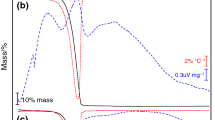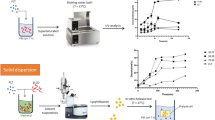ABSTRACT
Purpose
To prepare and characterize the co-crystal of dipfluzine and benzoic acid. To investigate the feasibility of the co-crystal for improving solubility and a faster dissolution rate in vitro and evaluate the bioavailability and tissue distribution of co-crystal in vivo.
Methods
A novel dipfluzine–benzoic acid co-crystal prepared using the solvent-assisted co-grinding and the solvent ultrasonic methods were identified and characterized by powder X-ray diffraction (PXRD), differential scanning calorimetry (DSC) and thermogravimetric analysis (TGA), as well as Raman, solid-state nuclear magnetic resonance (ssNMR), and terahertz (THz) spectroscopy. Pharmacokinetics and tissue distribution were tested in vivo using murine models. Statistics analysis for dissolution data of co-crystal in vitro and animal experiment data in vivo were evaluated using t-test.
Results
Results of PXRD and DSC identified the dipfluzine–benzoic acid co-crystals were formed with a molar ratio of 1:2. The IR, Raman, and ssNMR spectra verified the formation of O-H · · · O and O-H · · · F hydrogen bonds. The complex constant, K, was evaluated to be 109 orders of magnitude with Δ r G < 0. The co-crystal solubility, the rate of drug dissolution and the relative bioavailability were approximately 500 times, five times and double that of dipfluzine, respectively. Increased solubility of co-crystal did not reduce distribution in the brain; the mean concentrations in the brain increased, but the differences had no statistic significance (p > 0.05).
Conclusions
The co-crystal of dipfluzine–benzoic acid improved the physicochemical properties of dipfluzine, such as solubility and dissolution rate. Furthermore, the increased relative bioavailability of co-crystal indicated the potential use in further clinical study













Similar content being viewed by others
Abbreviations
- APIs:
-
Active pharmaceutical ingredients
- BA:
-
Benzoic acid
- CP:
-
Cross-polarization
- Dif:
-
Dipfluzine
- DSC:
-
Differential scanning calorimetry
- FT-IR:
-
Fourier-transform infrared
- MAS:
-
Magic-angle spinning
- PXRD:
-
Powder X-ray diffraction
- SD:
-
Spraque–Dawley
- ssNMR:
-
Solid-state nuclear magnetic resonance
- TGA:
-
Thermogravimetric analysis
- THz:
-
Terahertz
- TPPM:
-
Two pulse phase modulation
REFERENCES
Hauss DJ. Oral lipid-based formulations. Adv Drug Deliv Rev. 2007;59(7):667–76.
Connors RD, Elder EJ. Using a portfolio of particle growth technologies to enable delivery of drugs with poor water solubility. Drug Deliv Technol. 2004;4(8):78–83.
Limwikrant W, Higashi K, Yamamoto K, Moribe K. Characterization of ofloxacin-oxalic acid complex by PXRD, NMR, and THz spectroscopy. Int J Pharm. 2009;382(1–2):50–5.
Fand L, Numajiri S, Kobayashi D, Ueda H, Nakayama K, Miyamae H, et al. Physicochemical and crystallographic characterization of mefenamic acid complexes with alkanolamines. J Pharm Sci. 2004;93(1):144–54.
Blagden N, de Matas M, Gavan PT, York P. Crystal engineering of active pharmaceutical ingredients to improve solubility and dissolution rates. Adv Drug Deliv Rev. 2007;59(7):617–30.
Stanton MK, Bak A. Physicochemical properties of pharmaceutical co-crystals: a case study of ten AMG 517 co-crystals. Cryst Growth Des. 2008;8(10):3856–62. doi:10.1021/cg800173d.
Schultheiss N, Newman A. Pharmaceutical cocrystals and their physicochemical properties. Cryst Growth Des. 2009;9(6):2950–67.
Aaltonen J, Alles M, Mirza S, Koradia V, Gordon KC, Rantanen J. Solid form screening–a review. Eur J Pharm Biopharm. 2009;71(1):23–37.
Aaltonen J, Gordon KC, Strachan CJ, Rades T. Perspectives in the use of spectroscopy to characterise pharmaceutical solids. Int J Pharm. 2008;364(2):159–69.
Ueno Y, Ajito K. Analytical terahertz spectroscopy. Anal Sci. 2008;24(2):185–92.
Taday PF, Bradley IV, Arnone DD, Pepper M. Using terahertz pulse spectroscopy to study the crystalline structure of a drug: a case study of the polymorphs of ranitidine hydrochloride. J Pharm Sci. 2003;92(4):831–8.
Li D, Wang M, Yang CQ, Wang J, Ren GD. Solid state characterizations and analysis of stability in azelnidipine polymorphs. Chem Pharm Bull. 2012;60(8):995–1002.
Yang CQ, Zhang ZW, Zeng YL, Wang J, Wang YL, Ma BQ. Structures and characterizations of m-nisoldipine polymorphs. CrystEngComm. 2012;14(7):2589–94.
Lian WG, Lin YL, Wang M, Yang CQ, Wang J. Crystal engineering approach to produce complex of azelnidipine with maleic acid. CrystEngComm. 2013;15(19):3885–91.
Miao QF, Su SW, Zhang W, Guo MF, Li LF, Meng J, et al. Effects of dipfluzine on experimental arrhythmias and cytosolic calcium concentration. Chin J Pharmacol Toxicol. 2006;20(6):448–54.
Wang C, Zhang YJ, Wang YL. Effects of dipfluzine on delayed afterdepolarizations and triggered activity induced by ouabain in guinea pig papillary muscles. Acta Pharmacol Sin. 2002;23(10):905–9.
Zhang YJ, Wang YL, He RR. Effect of dipfluzine on isop renaline induced early afterdepolarizations and triggered activity. Chin J Pharmacol Toxicol. 2000;14(4):318–20.
Du YM, Wang YL, Zhang K, Gu JM. The synthesis methods of dipfluzine complex salts, Chinses patent CN101381349A; Mar 11, 2009.
Yang CQ, Wang J, Zhang ZW. Synthesis and spectra chatacteristic of pharmaceutical dipfluzine hydrochloride-benzoic acid co-crystal. Spectrosc Spectr Anal. 2011;31(9):2476–9.
20 Wang YL, Chen ZM, Bao CH, Zhang YJ. The synthesis methods of dipfluzine, Chinses patent CN 1326845C; July 18, 2007
Jin YH, Preparation and study of dipfluzine intragastric floating and residence sustained-release tablet. Master dissertation, Hebei Medical University. 2004
Schultheiss N, Newman A. Pharmaceutical cocrystals and their physicochemical properties. Cryst Growth Des. 2009;9(6):2950–67.
Aakeröy CB, Desper J, Scott BMT. Balancing supramolecular reagents for reliable formation of co-crystals. Chem Comm. 2006;13:1445–7.
Aakeröy CB, Desper J, Leonard B, Urbina JF. Toward high-yielding supramolecular synthesis: directed assembly of ditopic imidazoles/benzimidazoles and dicarboxylic acids into cocrystals via selective O-H · · · N hydrogen bonds. Cryst Growth Des. 2005;5(3):865–73.
Aakeröy CB, Fasulo ME, Desper J. Cocrystal or salt: does it really matter? Mol Pharm. 2007;4(3):317–22.
Wang J, Wang YL, Yang CQ. 1-Diphenylmethyl-4-[3-(4-fluorobenzoyl)propyl]piperazine-1,4-diium dichloride monohydrate. Acta Cryst. 2011;E67(10):o2719.
ACKNOWLEDGMENTS AND DISCLOSURES
This work was supported by the Fund of research and development in Science and Technology of Hebei Province of China (12276402D), the National Natural Science Funds of China (NSFC 81202504 and 11204191). The authors would like to express their sincere gratitude to Department of Physics, Capital Normal University, Beijing, China, for the terahertz spectroscopy equipment and School of Chemistry and Material Science, Hebei Normal University, Shijiazhuang, China, for DFT modeling simulation.
Author information
Authors and Affiliations
Corresponding author
Electronic supplementary material
Below is the link to the electronic supplementary material.
ESM 1
(DOC 520 kb)
Rights and permissions
About this article
Cite this article
Lin, Y., Yang, H., Yang, C. et al. Preparation, Characterization, and Evaluation of Dipfluzine–Benzoic Acid Co-crystals with Improved Physicochemical Properties. Pharm Res 31, 566–578 (2014). https://doi.org/10.1007/s11095-013-1181-6
Received:
Accepted:
Published:
Issue Date:
DOI: https://doi.org/10.1007/s11095-013-1181-6




